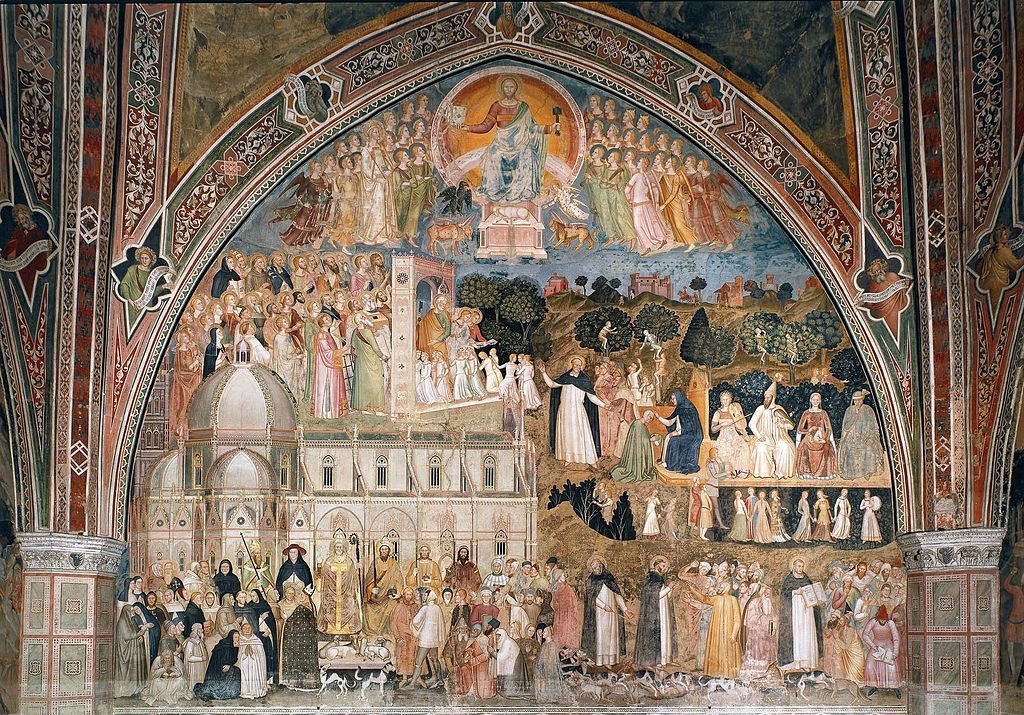Tuscany : Via Veritatus or the Church Militant and Church Triumphant
Dying of gout and mourning his wife, who had a died in the 1348 wave of bubonic plague, the wealthy Florentine merchant Buonamico di Lapo Guidalotti, guided by his close friend and mentor the Dominican Friar Jacopo Passavanti,decided to leave an extravagant 325 gold florins to have the inside of the Spanish Chapel of the Dominican Santa Maria Novella decorated with frescoes(1). Andrea da Firenze completed the painting of one of the more famous of these, later called the Via Veritatus or the Church Militant and Triumphant, in 1365 (1).
The upper half of the painting depicts the Church Triumphant (this denoting Christians who have ascended to heaven) standing among angels and centered around an enthroned Christ. The lower half of the fresco (concerning the Church Militant, or those remaining on Earth to do God’s work) includes haloed Christians on the upper right side being ushered through gates to behold the heavens awaiting them, while to their left youthful revelers enjoy earthly delights. In stark contrast to them, an old man to their immediate right seeks penance from two austere but benevolent Dominican Friars, identifiable by their black and white robes (2). Dominicans also feature prominantly among clergy surrounding the important secular and religious leaders seated in front of a cathedral dome in the lower right side. Guidalotti and Passavanti used the painting to stress the importance of the Dominican order within the Church and promote Dominican ideals, which had become increasingly radically anti-semitic following the 1348 plague. In the bottom right, St. Peter Martyr and St. Thomas attempts to convert heretics, among them Jews, who are identifiable by their grossly stereotyped features and yellow garments(3), while St. Dominic drives black and white dogs (Domini canes, a symbol of the Dominican order) onward to defend a flock of sheep, representing good Christian society from snarling wolves, the heretics among said society(1). The Dominicans did not just believe the Jews to be willfully ignorant heretics. Increasingly in the decades following the 1348 plague, which many attributed to God’s wrath, their sermons also compared the Jews to a disease, like the plague, which must be expelled lest it kill the whole body of good Christian society in Florence(4).
The Dominican order of the Roman Catholic Church, founded in 1216 by St. Dominic de Guzman, had from the beginning focused on converting Jews or expelling them from Christian society(5). While it seems that the plague, in it’s role as a supposed punishment from God, did influence Dominicans to be more anti-Semitic, conceivably they were also astute in exploiting the fear that followed it to promote and preach more publicly the extreme views they had long held. Perhaps, in advising Andrea da Firenze on the themes to be depicted in the Via Veritatus, Passavanti was one such Dominican.
Sources Cited:
1. Brown, James Wood. The Dominican Church of Santa Maria Novella at Florence. O. Schulze & Company 1902. 36-48. eBook
2. Joseph Polzer. "Andrea di Bonaiuto’s Via Veritatis and Dominican Thought in Late Medieval Italy," The Art Bulletin . 77, no. 2 (1995): 262-289, http://www.jstor.org/stable/3046101 Web. 26 Feb, 2014
3. Chester Jordan, William. "The Last Tormentor of Christ: An Image of the Jew in Ancient and Medieva Exegesis, Art, and Drama." The Jewish Quarterly Review. Center for Advanced Judaic Studies, University of Pennsylvania, 2014. Web
4. Ben-Aryeh Debby, Nirit. "Art and Sermons: Dominicans and the Jews in Florence’s Santa Maria Novella." Church History and Religious Culture. Academia.edu, 2012. Web. 9 Feb. 2014
5. Levy, Richard S. "The Dominicans." Antisemitism: A Historical Encyclopedia of Prejudice and Persecution. 1. Santa Barbara: 2005.

